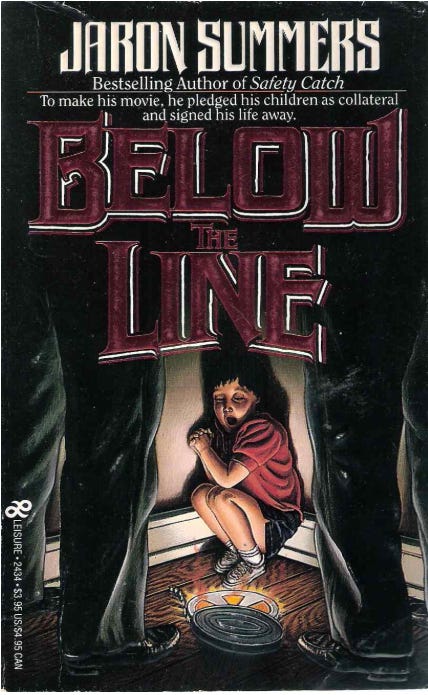Reading This is No Use to You
On "Below the Line" by Jaron Summers, and "Full Dark, No Stars" by Stephen King
[Reminder that this is a break from format, in order to bring my paid subscribers a special series of posts about horror literature during the month of October, because October has Halloween at the end of it] [THIS POST CONTAINS REFERENCES TO SEXUAL VIOLENCE, RAPE, AND MOLESTATION, BE WARNED]
I. Eyes That Belonged to a Cobra
Author Never Read: Jaron Summers
Book Read: Below the Line
Recently, there was an article in the New York Times which upset some of my friends and colleagues. The gist of the article was that sometimes, movies are so bad that they loop around to becoming good, if you can even imagine such a thing. The writer described all of this as if it were a new idea, which is obnoxious enough. The real problems set in when she named John Woo’s Face/Off as the kind of movie she was talking about. Now, this didn’t upset me as much as it did the aforementioned friends and colleagues, but only because I don’t hold Face/Off in quite the same high esteem as they do. But I do like it. I think it’s good, and I don’t think it’s good because it’s bad, but rather because it is a pretty uncomplicatedly entertaining, and indisputably well-made, action film.
I bring this up because of today’s first book, Below the Line by Jaron Summers, the cover of which is pictured above, in place of a picture of Summers himself, which is what I’d normally do, because while I could find images of a writer by that name, I could find no confirmation on his website that he’d written a novel called Below the Line. And while it could be him, why lay the weight of such blame on someone I don’t know for certain to be the guilty party? Also, and not incidentally, there are a lot more Jaron Summerses out there than you might guess. Anyway, this novel came out, absent any fanfare that I could find (though this Summers had had a bit of a bestseller with a previous tech thriller called Safety Catch) in 1987. As an 11-year-old, it wasn’t on my radar then, and only became so well into my adulthood, when Grady Hendrix mentioned it in Paperbacks from Hell, his amusing “What a Time it Was”-type compendium on the heyday, or nadir, depending on who you ask, of the mass market paperback boom in horror fiction from the 70s and, especially, through the 80s. In choosing to read Below the Line for this project, I chose not to refamiliarize myself with what Hendrix had to say about it, but as I recall he made a note of how berserk the novel is — a note Hendrix makes about most of the books he discusses in Paperbacks from Hell (and speaking of which, I think the book Hendrix talks about that has gained the greatest notoriety as a result is The Voice of a Clown by Barbara Brown Canary, a used copy of which I ordered online (don’t remember the price, but it was one I was willing to pay — I have not seen it for a price I am willing to pay since then); got the notification it was in the mailbox, it was not in the mailbox, notified the seller, they said sorry, here’s your refund, and if the book ever shows up you can keep it; great customer service, the book never showed) — and not only berserk, but, again returning to another oft-repeated theme, berserk in an especially twisted way. Good enough for me, I guess I apparently thought, because I found a copy and bought it.


